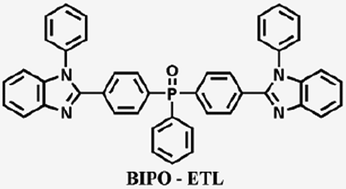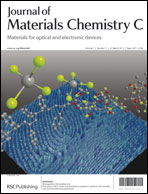A highly efficient new benzoimidazole phosphine oxide based electron transporting material, bis(1-phenyl-1H-benzo[d]imidazole)phenylphosphine oxide (BIPO), was designed, synthesized by condensation, nucleophilic substitution and oxidation reactions, and confirmed using various spectroscopic studies. It shows a thermal stability (ΔT5%) of 451 °C with a glass transition temperature of 129 °C from the thermogravimetric analysis and differential scanning calorimetry studies. BIPO used as an efficient electron transport layer (ETL) in a green emitting phosphorescent organic light emitting diode, ITO/4,4′-bis[N-(1-naphthyl)-N-phenyl-amino]biphenyl (30 nm)/4,4′,4′′-tris(carbazole-9-yl)triphenylamine 10 nm)/(4,4′-N,N′-dicarbazole)biphenyl (CBP) host doped with Ir(ppy)3 dopant (5%) (30 nm)/ETL (40 nm)/LiF (1 nm)/Al (100 nm), serves as an effective hole-blocking material and improves the charge balance in the device, resulting in higher device efficiencies of 22.19%, 68.3 cd A−1 and 24.4 lm W−1 with a maximum luminance of 72 080 cd m−2 compared to those (17.03%, 52.0 cd A−1 and 20.9 lm W−1 with a maximum luminance of 33 490 cd m−2) of a device using a widely used ETL, 1,3,5-tris(m-pyrid-3-yl-phenyl)benzene. These results show that the new BIPO ETL could be very useful in efficient organic light emitting diodes.


 Please wait while we load your content...
Please wait while we load your content...